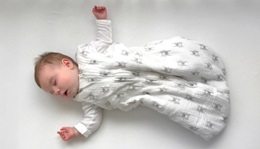Safe-Sleep
Understanding safe sleep guidelines can help protect against sudden infant death syndrome. Find information on how to create a safe sleep environment and tips for a consistent bedtime routine.
Sleep is one of the first things new parents sacrifice for themselves when their newborn arrives, and many wonder when their baby will sleep through the night.
Setting up a good sleep environment with babies in their own crib on their back, and having consistent routines will help your child sleep and put your mind to rest.
Sudden Infant Death Syndrome (SIDS)
SIDS is the sudden, unexplained death of a baby younger than 1 year of age and is the leading cause of death in babies 1 month to 1 year old. SIDS is sometimes called "crib death" or "cot death" because it is associated with the timeframe when the baby is sleeping. Cribs themselves don't cause SIDS, but the baby's sleep environment can influence sleep-related causes of death.
Ways to Reduce the Risk of SIDS
There is no way to 100 percent prevent SIDS, but there are many ways to reduce your child's risk, including:
- Place on back to sleep. Always place babies on their back in their own crib to sleep.
- Don’t smoke. Don’t expose your baby to cigarette smoke before or after birth.
- Don’t bed-share. Never fall asleep with your baby in your bed or in a chair or sofa. Sleeping in the same room is great. The same bed is not.
- Place in bare crib. Avoid putting anything inside the crib that could suffocate a baby, such as blankets, pillows, bumper pads, positioning devices or stuffed animals. Be sure the crib has tightly fitted sheets. Make your crib bare, basic and boring.
- Keep it cool. Keep the temperature in your baby’s bedroom cool.
- Breastfeeding. Breast milk is thought to have some protective factors for SIDS.
It’s also important that babies get plenty of tummy time while they are awake so they can strengthen their head and neck muscles. Tummy time also helps prevent babies from getting a misshapen or flat head. Remember the phrase: “Back to sleep; tummy to play.”
Normal Newborn Breathing
Even with today’s high-tech night vision video monitors, many new parents may still worry and check on newborns after they go to sleep to see if they are still breathing. Signs your baby is breathing normally, include:
- Chest slightly moving up and down
- Hearing light breaths
- Normal coloring to baby's face and body
Newborn Breathing: When to be Concerned
While uncommon, you should be concerned if your baby shows the following signs:
- Heavy or consistent rapid breathing
- Lack of movement in the chest area and other inconsistencies in breathing
If you notice any of these, contact your pediatrician, or in an emergency, dial 911, then start the basics of infant CPR from the American Heart Association.
Infant CPR from the American Heart Association
- Tapping baby’s foot to check for movement
- Beginning chest compressions—place two fingers below the nipple line and start 30 compressions
- Open the airway and administer two breaths for every 30 compressions by tilting the baby’s head back slightly and watching for the chest to rise
- Continue CPR until the baby is resuscitated or until emergency help arrives
Baby Bedtime Routines
Establishing a consistent bedtime routine for your baby is important. The routine should ideally start at the same time every night. As soon as the sun goes down, start to wind down the household.
- Dim the lights
- Stop use of electronics/screens at least an hour before bed
- Take a warm bath
- Do a quiet family activity such as reading a short book
Recommended Amount of Sleep for a Child
It varies based on age. The American Academy of Pediatrics recommends:
- Infants under 1 year: 12-16 hours
- Children 1-2 years old: 11-14 hours


